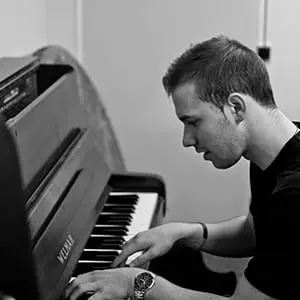How to Play Boogie Woogie Piano
Boogie Woogie Piano will boost your piano technique. Give it a try today!

Hello there, Jack Marshall here from the London Contemporary School of Piano. Thank you for joining me today as we dive into how to play boogie woogie piano. This lesson is tailored for beginners, so even if you’re new to the piano, you’ll find it accessible and enjoyable.
If you appreciate the work we do at LCSP, be sure to check out our website where you can request our free resources pack. It’s packed full of great materials that will help you with your playing—something I would have loved to have when I was learning!
Introduction to Boogie Woogie Piano
Boogie Woogie is a dynamic and energetic style of piano playing that originated from the blues. It’s characterized by a repetitive left-hand bass pattern and lively right-hand rhythms. In this lesson, we’ll break down the steps on how to play boogie woogie piano, focusing on both the left and right hand and how to combine them effectively.
Watch the Video Tutorial
For a visual guide on how to play boogie woogie piano, check out my full video lesson below which support the tips I’m going to give you in this article.
Step 1: Mastering the Left-Hand Pattern
The left hand is the backbone of boogie woogie piano. It’s relatively straightforward but requires consistency and stamina. We’ll be using a pattern based on the C chord, moving through the 12-bar blues progression.
Left-Hand Pattern on C
Start by familiarizing yourself with these two shapes:
- Shape 1: Little finger (5) on C, second finger (2) on G.
- Shape 2: Little finger (5) on C, thumb (1) on A.
Alternate between these two shapes, playing each twice:
C (5) + G (2), C (5) + G (2) C (5) + A (1), C (5) + A (1)
Practice this pattern slowly until it feels comfortable. The goal is to play it consistently and smoothly, to the point where you can have a conversation while your left-hand keeps going.
Left-Hand Patterns for F and G
Since we’re following a 12-bar blues form, we’ll also use patterns for the F and G chords:
F Chord Left-Hand Pattern
- Shape 1: Little finger (5) on F, second finger (2) on C.
- Shape 2: Little finger (5) on F, thumb (1) on D.
G Chord Left-Hand Pattern
- Shape 1: Little finger (5) on G, second finger (2) on D.
- Shape 2: Little finger (5) on G, thumb (1) on E.
Left-Hand Pattern Diagram
| Chord | Shape 1 (Fifth) | Shape 2 (Sixth) |
|---|---|---|
| C | C and G | C and A |
| F | F and C | F and D |
| G | G and D | G and E |
Tip: Get comfortable with this left-hand pattern before moving on. It’s essential to keep it steady and consistent throughout your playing.
Step 2: Learning the Right-Hand Pattern
The right hand adds melody and rhythm to your boogie-woogie playing. We’ll use a pattern that complements the left hand, focusing on chord shapes and a seesaw motion.
Right-Hand Pattern on C
The right hand will use three chord shapes:
- Shape 1: C major chord (C, E, G)
- Shape 2: F major chord inversion (C, F, A)
- Shape 3: G7 chord (B♭, E, G)
The seesaw motion involves alternating between the top two notes and the bottom note:
Play top two notes (E and G), then bottom note (C) Move to next shape: top two notes (F and A), then bottom note (C) Move to next shape: top two notes (G and B♭), then bottom note (E) Return to previous shape: top two notes (F and A), then bottom note (C)
Right-Hand Fingering Suggestions
Use fingering that feels comfortable, but here’s what I recommend:
- Shape 1: Thumb (1) on C, second finger (2) on E, fourth finger (4) on G.
- Then, move your third finger (3) and fifth finger (5) up for the next shapes.
Tip: Always start with the top two notes, then play the bottom note. This helps maintain the rhythm and flow.
Sliding Technique
To add a bluesy feel, use a sliding technique:
- Slide from the minor third (E♭) to the major third (E) in the C major chord.
- This can be applied to other chords as well, like sliding into the F and G chords.
Step 3: Combining Both Hands
Now, let’s put it all together. This is often the most challenging part, so take it slow. The key is synchronization – every time you play a note in the right hand, there’s a corresponding note in the left hand.
Tips for Combining Hands
- Start without worrying about rhythm; focus on playing the correct notes together.
- Practice in small sections, mastering one measure at a time.
- Keep the left hand steady, acting as the engine driving the rhythm.
Breaking It Down Measure by Measure
Here’s how you can approach the first measure:
- Left hand plays Shape 1 (C and G) twice.
- Right hand plays Shape 1 in seesaw motion.
Proceed to the next measure, moving to the next shapes in both hands and so on.
Step 4: Playing the 12-Bar Blues Progression
Now that you’ve practiced both hands separately and together, it’s time to play through the entire 12-bar blues progression.
12-Bar Blues Structure
- Bars 1-4: C chord
- Bars 5-6: F chord
- Bars 7-8: C chord
- Bar 9: G chord
- Bar 10: F chord
- Bars 11-12: C chord
Tip: Practice transitioning between chords smoothly. Use the same patterns we’ve discussed for each chord.
Adding Chromatic Walking Basslines
To enhance your boogie-woogie playing, you can incorporate chromatic walking basslines when transitioning between chords.
Transition from C to F
On the fourth bar, walk up from C to F using these notes:
C, D, E♭, E, F
This creates a smooth transition into the F chord on bar 5.
Transition from C to G
Before moving to the G chord, use this ascending line:
C, E, F, F♯, G
Integrating the Basslines
Practice these transitions slowly, ensuring your left and right hands remain synchronized. This adds a professional touch to your playing and keeps the momentum going.
Exploring Variations
Once you’re comfortable with the basic patterns, try experimenting with variations to make your playing more interesting.
Changing the Right-Hand Order
Instead of always playing bottom-middle-top, mix up the order:
- Start from the top note and descend.
- Alternate the pattern randomly to add variety.
This is very important when learning how to play boogie woogie piano.
Introducing Stride Piano Elements
Switch up your left-hand pattern to a stride piano style for a different feel:
Alternate between a bass note and a chord in the left hand.
This can be combined with the same right-hand patterns or new ones.
Practice Tips for Mastery
- Repetition: Consistent practice helps build muscle memory.
- Slow Down: Start at a slow tempo to ensure accuracy.
- Focus on Timing: Use a metronome to keep a steady beat.
- Listen Actively: Pay attention to how both hands interact.
Conclusion
Learning how to play Boogie Woogie piano is a fun and exciting style to learn. By mastering the left-hand patterns and combining them with the right-hand rhythms, you’ll be able to play with confidence and flair. Remember to take it step by step, and don’t rush the process.
If you enjoyed this lesson on how to play boogie woogie piano, don’t forget to grab our free resources pack from the LCSP website. It’s filled with valuable materials to further enhance your playing.
Thank you for joining me today. Happy practicing and I’ll see you in the next lesson!
To check out more of our piano tips you should subscribe to our YouTube channel where you will find many joyful tutorials.
